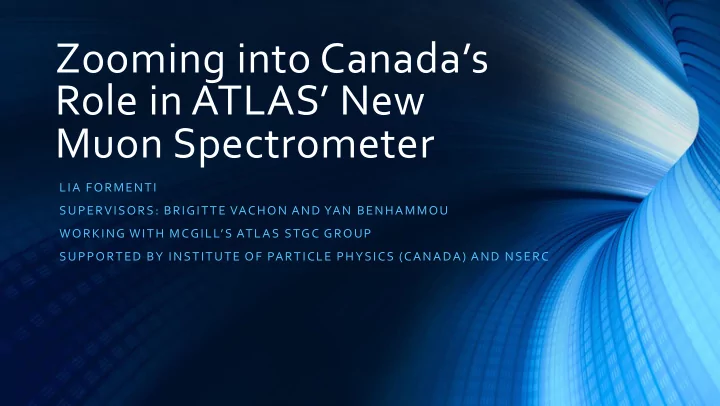

Zooming into Canada’s Role in ATLAS’ New Muon Spectrometer LIA FORMENTI SUPERVISORS: BRIGITTE VACHON AND YAN BENHAMMOU WORKING WITH MCGILL’S ATLAS STGC GROUP SUPPORTED BY INSTITUTE OF PARTICLE PHYSICS (CANADA) AND NSERC
Outline • The future of LHC and ATLAS • Why the muon small wheel needs replacing • Small strip thin gap chamber testing • My role • Project progress 2
LHC and ATLAS • LHC: Large Hadron Collider – world’s largest accelerator • Four experiments, including ATLAS 100 m 27 km around https://www.swissinfo.ch/eng/sci-tech/the-big-bang- machine-is-back_what-s-next-for-cern-s-large- 3 hadron-collider-/41337172
http://hilumilhc.web.cern.ch/about/hl-lhc-project 4
http://hilumilhc.web.cern.ch/about/hl-lhc-project 5
http://hilumilhc.web.cern.ch/about/hl-lhc-project 6
NOW http://hilumilhc.web.cern.ch/about/hl-lhc-project 7
ALTAS’ Muon Reconstruction • Muons pass through all ~40 m inner layers • Three wheels make up endcap muon detection system • Feeds into level 1 trigger ~20 m – do we record data from this event? • Position and momentum reconstruction Outer wheel Small Wheel Big Wheel Collision point 8 https://www.eurekalert.org/multimedia/pub/88092.php
https://mediastream.cern.ch/MediaArchive/Photo/Public/2007/0709002/0709002 9 _01/0709002_01-A4-at-144-dpi.jpg
Old Small Wheel New Small Wheel Problems: Solutions: • Increased number of collisions • New small wheel data will also will degrade efficiency and be used for triggering position resolution • New detectors designed to • Muon system only uses middle handle increased trigger rate wheel for triggering • Precise muon track • 90 % of triggers are fake [1] reconstruction https://mediastream.cern.ch/MediaArchive/Photo/Public/2007/0709002/0709002 10 _01/0709002_01-A4-at-144-dpi.jpg
New Small Wheel Construction • Make wedges of detectors to fill wheel • Sandwich sTGCs and MicroMegas • MicroMegas are the primary tracker • sTGCs are the primary triggers [1] 11
12
Small Strip Thin Gap Chambers ( sTGC’s ) • Muon ionizes gas in gap • Ionization products induce current on wires, pads and strips • Pads provide region of interest and coarse tracking • Strips and wires provide finer position resolution • Four sTGCs stacked to make quadruplet [2]13
sTGC Production and Testing in Canada McGill University, Montreal QC: Chamber testing with cosmic muons TRIUMF, Vancouver BC: Raw material preparation Carleton University, Ottawa ON: Chamber construction 14
Testing with Cosmic Muons at McGill • Muon flux: ~ 1 muon / cm 2 / min • Use scintillators to trigger detector readout • Use tests to get noise level, efficiency map, and position resolution [3] 15
McGill’s sTGC Laboratory Slow control Test bench Gas system system 16
Electronics and Temperature Control • All wires’, strips’ and pads’ signals are readout by electronic boards • DC – DC voltage converter (FEAST) dissipates so much heat it requires cooling • Tested various heat sinks, helped build temperature monitoring infrastructure Thermal image of Analog 1.2 V FEAST during operation, ~ 35 ⁰C 17
Temperature Monitoring Infrastructure Prepared RTDs and cables for temperature monitoring Added RTDs to central DAQ: Wrote program and National Instruments designed interface for compact DAQ temperature monitoring 18
Transport First production quadruplet arrives at CERN! First production quadruplet from Carleton to McGill 19
• Can use beam from pre Testing at CERN – accelerator to test chambers with a higher rate than cosmic muons • Goals: • Does the quadruplet work? • Characterize chamber and electronics Secondary detector • Best settings for electronics • Use a secondary Beam detector to confirm the presence of muons to calculate efficiency 20
Efficiency Measurements • When secondary detector fires, record data from sTGC using oscilloscope • The number of pulses recorded compared to the number of triggers gives the efficiency • Prototype sTGC wedge over 97 % efficient 21
Current Tests: High Background in Gamma Irradiation Facility • Last week, craned over the quadruplet into GIF++ • Activity: 13.6 TBq (367 Ci) • Testing to see if the detector performs well in a radiation background similar to in ATLAS • Also have muon beam to continue testing and characterizing electronics and chamber response 22
Conclusion • Muon New Small Wheel needs replacing so that ATLAS can continue to run effectively • Multinational project with Canada being one of five countries involved in sTGC production • First production quadruplet is at CERN, with more predicted to arrive in the next months • Testing at CERN to learn how to best use these detectors in ATLAS 23
• Brigitte Vachon Acknowledgements • Steven Robertson • Yan Benhammou • Gerardo Vasquez • Tony Kwan • Kathrin Brunner • AlamToro Salas • Rimsky Rojas Caballero • Paris Franz • Nicolas Viaux Maira • Charlie Chen • Evan Carlson 24 Contact me at lforment@uoguelph.ca
References [1] B. Stelzer, Nuclear and Particle Physics Proceedings 273 – 275 , 1160 (2016). [2] E. Perez Codina, Nuclear Instruments and Methods in Physics Research Section A: Accelerators, Spectrometers, Detectors and Associated Equipment 824 , 559 (2016). [3] Leger, Felix, Studies of Cosmic Ray Events in ATLAS STGC Muon Chamber Prototypes, McGill University, 2017. 25
Landau Distribution of Pulse Heights • Energy deposited by muons fits a Landau distribution • Mostly, a certain fraction of their energy is deposited, but as they slow down lots of energy can be transferred per interaction 26 Energy, arbitrary units
Different Configurations • Lower gain Without source With source Normalized Counts 27
Different Configurations • Higher gain Without source With source Normalized Counts 28
Countries Involved in sTGC Production: Canada, Chile, China, Israel, Russia 29
Temperature Monitoring and Cooling • Monitor temperature with surface mount RTDs • Use fans, Gap Pad and heat sinks for cooling 30
Recommend
More recommend